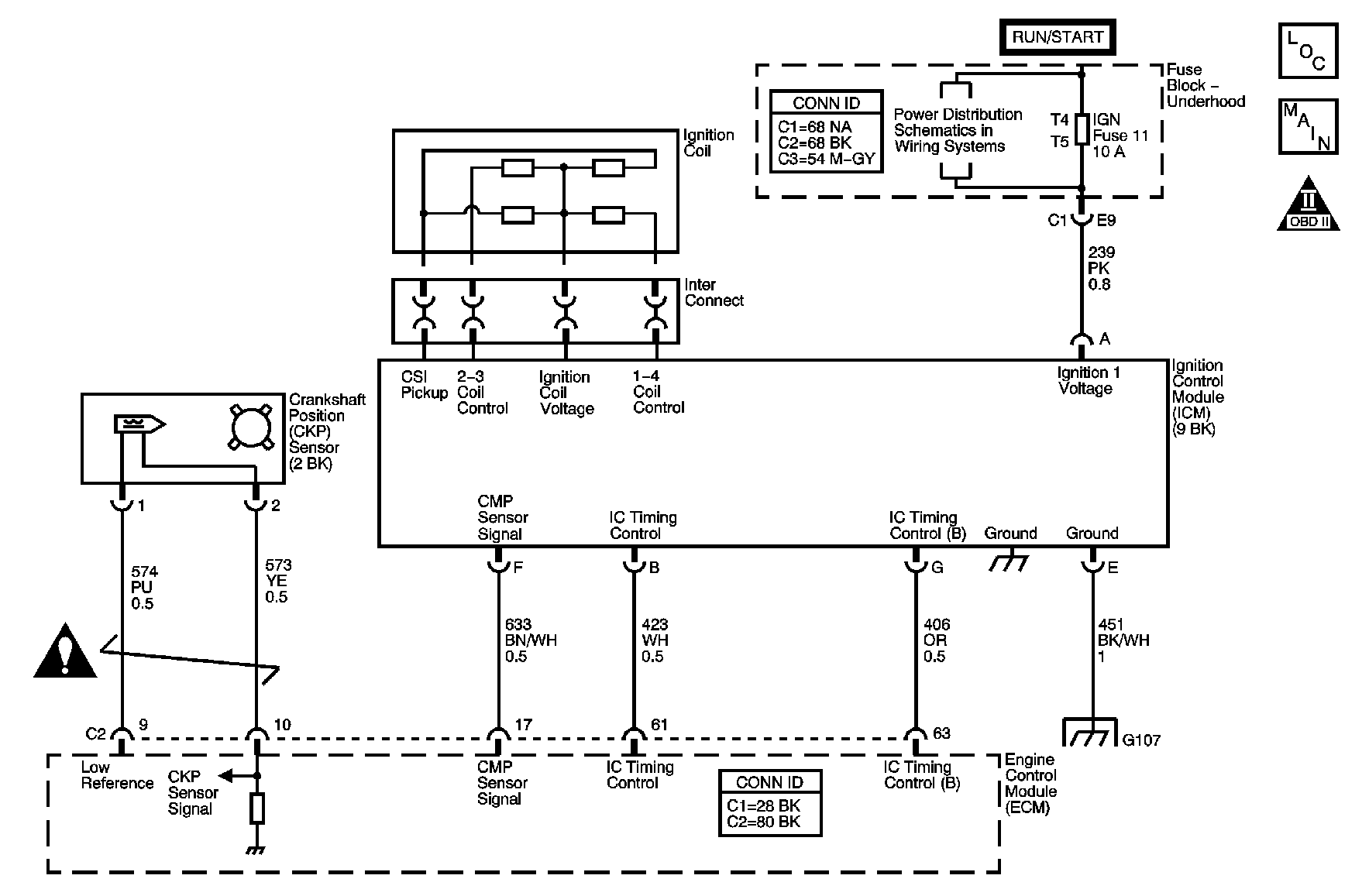
Circuit Description
Each ignition coil supplies secondary voltage to a pair of spark plugs. This is called a waste spark ignition system. The engine control module (ECM) supplies a signal on each of the ignition control (IC) timing control circuits to the ignition control module (ICM). The ICM fires the correct ignition coil at the correct time based on the signals. The ICM detects if cylinder 1 or cylinder 3 is on the compression stroke by sensing the secondary voltage and polarity of each side of the ignition coil. The higher voltage is on the compressing cylinder. This is called compression sense ignition. The ICM provides a synthesized cam signal to the ECM based on these inputs. The ECM uses the cam signal to synchronize fuel injection. This system consists of the following circuits:
| • | The ignition 1 voltage circuit |
| • | The ground circuit |
| • | The camshaft position (CMP) sensor signal circuit |
| • | The IC timing control for cylinders #1 and #4 |
| • | The IC timing control B circuit for cylinders #2 and #3 |
Step | Action | Values | Yes | No |
|---|---|---|---|---|
Schematic Reference: Engine Controls Schematics Connector End View Reference: Engine Controls Connector End Views or Engine Control Module Connector End Views | ||||
1 | Did you perform the Diagnostic System Check-Engine Controls? | -- | Go to Step 2 | |
2 |
Does the CMP Resync counter increment? | -- | Go to Step 3 | |
3 |
Does the spark tester spark on all cylinders? | -- | Go to Step 6 | Go to Step 4 |
4 | Is the no spark condition only present on one cylinder? | -- | Go to Step 14 | Go to Step 5 |
5 | Is the no spark condition only present on companion cylinders 1-4 or 2-3? | -- | Go to Step 12 | Go to Step 8 |
6 | Does the spark tester indicate a bright blue spark on all cylinders? | -- | Go to Step 7 | Go to Step 14 |
7 |
Are the spark plugs in good condition? | -- | System OK | Go to Step 20 |
8 |
Does the test lamp illuminate? | -- | Go to Step 9 | Go to Step 16 |
9 | Connect a test lamp from the ignition voltage circuit to the ground circuit of the ICM. Does the test lamp illuminate? | -- | Go to Step 10 | Go to Step 17 |
10 |
Is the resistance less than the specified value? | 3 ohms | Go to Step 11 | Go to Step 18 |
11 | Measure the resistance of the ground circuit of the ICM from the harness connector of the ICM to a good ground. Is the resistance less than the specified value? | 3 ohms | Go to Step 12 | Go to Step 19 |
12 |
Important: If using a different test lamp, the bulb resistance needs to be 4 ohms or less. Does the test lamp illuminate? | -- | Go to Step 13 | Go to Step 15 |
13 |
Does the test lamp flash? | -- | Go to Step 14 | Go to Step 15 |
14 | Test for shorted terminals or a poor connection at the ignition coil housing. Refer to Testing for Intermittent Conditions and Poor Connections and Connector Repairs in Wiring Systems. Did you find and correct the condition? | -- | Go to Step 23 | Go to Step 21 |
15 | Test for shorted terminals or a poor connection at the ICM. Refer to Testing for Intermittent Conditions and Poor Connections and Connector Repairs in Wiring Systems. Did you find and correct the condition? | -- | Go to Step 23 | Go to Step 23 |
16 | Repair an open or short to ground in the ignition voltage circuit of the ICM. Refer to Wiring Repairs in Wiring Systems. Did you complete the repair? | -- | Go to Step 23 | -- |
17 | Repair an open in the ground circuit of the ICM. Refer to Wiring Repairs in Wiring Systems. Did you complete the repair? | -- | Go to Step 23 | -- |
18 | Repair the high resistance in the ignition voltage circuit of the ICM. Refer to Wiring Repairs in Wiring Systems. Did you complete the repair? | -- | Go to Step 23 | -- |
19 | Repair the high resistance in the ground circuit of the ICM. Refer to Wiring Repairs in Wiring Systems. Did you complete the repair? | -- | Go to Step 23 | -- |
20 | Replace the spark plugs. Refer to Spark Plug Replacement . Did you complete the replacement? | -- | Go to Step 23 | -- |
21 | Replace the ignition coil housing. Refer to Ignition Coil Housing Replacement . Did you complete the replacement? | -- | Go to Step 23 | -- |
22 | Replace the ICM. Refer to Ignition Control Module Replacement . Did you complete the replacement? | -- | Go to Step 23 | -- |
23 |
Does the vehicle operate normally? | -- | System OK | Go to Step 3 |
